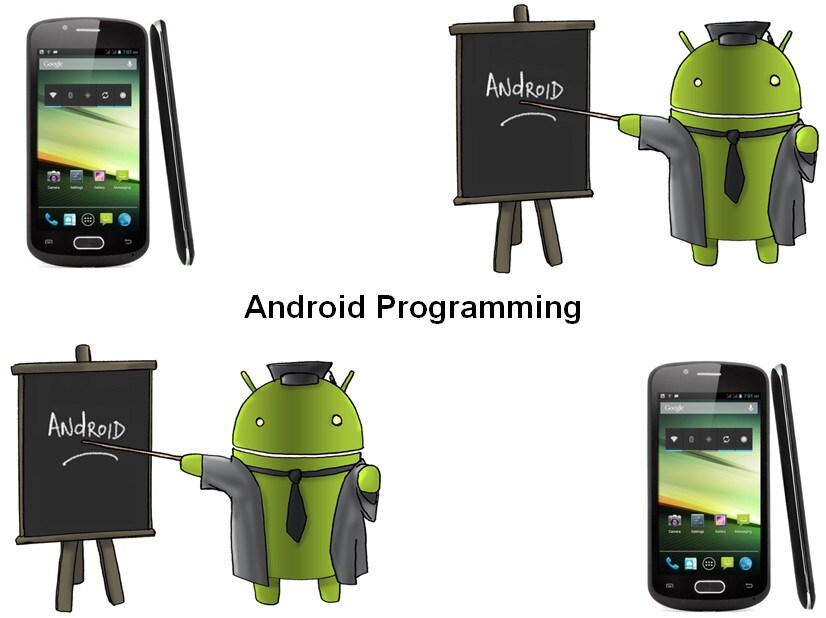-
Learning by doing
-
Trainers with practical experience
-
Classroom training
-
Detailed course material
-
Clear content description
-
Tailormade content possible
-
Training that proceeds
-
Small groups
In the course Android Programming participants learn app development for the Android operating system for mobile devices. The course uses the latest version of Android and the apps are developed in Java or Kotlin.
The course Android Programming starts with a global overview of the Android operating system, which is based on a modified Linux kernel. Also discussed is how Android differs from other platforms.
Subsequently the main building blocks of Android apps are covered such as activities, views, intents, services, content providers, fragments and the AndroidManifest.xml.
The UI can be realized in Android using fragments and xml layout, but in the newer Android versions the UI is realized with composable functions. Both ways are treated in the course Android Programming with emphasis on the latter.
Preferences are also part of the course Android Programming including writing and reading shared preferences. Attention is also paid to reading and writing files to internal and external storage facilities.
Advanced User Interfaces that make use of complex components and their interaction are covered as well. Design Patterns such as the MVVM or MVI Pattern and observable data types with live data are treated.
Best practices, debugging and testing apps on devices are also on the schedule. The course Android Programming uses the latest version of the Android OS with Android Studio as IDE and emulators for devices.
Storing data locally in an SQLite database is also covered. This includes working with cursors for inserts and updates. Benefits of Design Patterns for data storage such as the DAO (Data Access Objects) Pattern and ViewHolder Pattern are explained.
Finally content providers with various MIME types and support for multimedia such as audio and video are discussed.
The course Android Programming is intended for experienced Java developers who want to learn how apps can be programmed for Android with Java or Kotlin.
To participate in the course Android Programming knowledge of and experience with programming in Java or Kotlin is required.
The theory is discussed on the basis of presentation slides. Demos provide an illustrative clarification of the discussed concepts. The theory is interspersed with exercises. The course material is in English.
Participants receive an official certificate Android Programming after successful completion of the course.

Module 1 : Android Overview |
Module 2 : Main Building Blocks |
Module 3 : Activities and UI |
|
Android Stack Android Architecture Java versus Kotlin Dissecting Android apps Building blocks Debugging and Testing Android Security The manifest file Layout resource Running your app on Emulator |
Activities Activity lifecycle Destroy the Activity Pause Your Activity Resume Your Activity Stop Your Activity Intents Services Content Providers Broadcast Receivers |
Understand the Lifecycle Callbacks Specify Your App's Launcher Activity Create a New Instance Start/Restart Your Activity XML Layout Fragments Composable Functions Views and Layouts Common UI Components Handling User Events |
Module 4 : Preferences and Files |
Module 5 : Advanced UI |
Module 6 : Device Support |
|
Get a Handle to a SharedPreferences Write to Shared Preferences Read from Shared Preferences Choose Internal or External Storage Obtain Permissions for External Storage Save a File on Internal Storage Save a File on External Storage Query Free Space |
Selection Components Adapters Complex UI Components MVVM and MVI Pattern Observable Data Types Building UI for Performance Menus and Dialogs Graphics and Animations |
Create Locale Directories String Files Use the String Resources Create Different Bitmaps Minimum and Target API Levels Debugging and Testing Use Platform Styles Use Platform Themes |
Module 7 : SQL Database |
Module 8 : Content Providers |
Module 9 : Multimedia in Android |
|
Introducing SQLite Creating a Database Opening and Closing a Database Working with Cursors Inserts, Updates and Deletes DAO en ViewHolder Patterns |
Content provider MIME types Searching for Content Adding Content Changing Content Removing Content Working with Content Files |
Multimedia Support Audio formats Jet Player Simple Media Playback Supported Video Formats Simple Video Playback |
